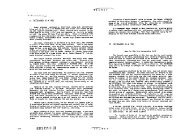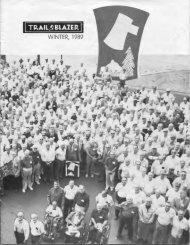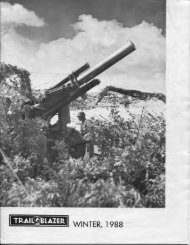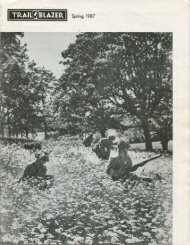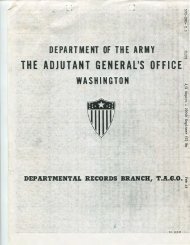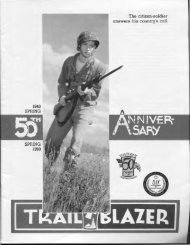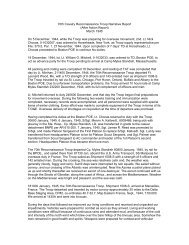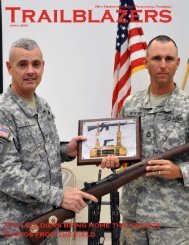Download - 70th Infantry Division Association
Download - 70th Infantry Division Association
Download - 70th Infantry Division Association
Create successful ePaper yourself
Turn your PDF publications into a flip-book with our unique Google optimized e-Paper software.
weapons, squad and platoon attack problems (day and night), field firing, scouting and patrolling, use of<br />
the compass, etc. It was also ordered that some phases of training be conducted by troops occupying<br />
defensive positions.<br />
The regimental training plan called for rotating battalions as reserve so that four or five days at a time<br />
would be allowed each for carrying out the instruction program. The writing of Squad and platoon<br />
problems was assigned to the various battalions. Operations on our part from 11 February to 16 February<br />
consisted chiefly of improvement of defensive positions and the conduct of active patrolling.<br />
February 11 we were back on the front lines and we had nine guys go to the hospital, although I can't<br />
remember the action of that particular day. On February 12, we dropped four guys missing in action and<br />
we actually got a new guy from replacement depot.<br />
The regiment was now receiving aggressive air support. One bombing mission on 13 February against an<br />
enemy paper mill at Marienau, where four machine gun positions had been reported, resulted in 50<br />
percent destruction of the factory.<br />
On the same date an order was received from <strong>Division</strong> that each regiment would conduct a raid of at least<br />
platoon strength once a week. The raiding unit was not to be of company size.<br />
Changes in the battle order on 15 February placed Company A on the MLR, relieving Company C, which<br />
went into First Battalion reserve, while the <strong>70th</strong> <strong>Division</strong> Reconnaissance Troop relieved Company L and<br />
elements of Company M. Company K and Company L then became Third Battalion reserve. The sector at<br />
this time was quiet. The regimental train was moved forward from St. Avold to Hombourg Haut.<br />
On February 13 in Cocheren, France, we got 34 enlisted men assigned to duty from the replacement<br />
depot. That meant something was getting ready to happen again. When you lose a jeep, if they give you<br />
a replacement that meant you were getting ready to run again. And if you got replacement men,<br />
something was up. February 14th we started to run some company squad problems because we had new<br />
men and we wanted to see how the company runs with squad problems. We were going to run platoon<br />
problems in area 19 in St. Avold, France. We had to work as a unit because if you didn't, you were a dead<br />
duck. We had to find out what the new men knew and what they didn't know because our lives depended<br />
on what they did. Now, you can imagine on the front lines, running problems. We were playing cops and<br />
robbers on the front lines which seems like the silliest thing, but it had to be done. We departed<br />
Cocheren, France on February 16 at 1700 and arrived at Morsbach at 2000. Travel was by motor convoy<br />
manning positions on outpost line of resistance at Morsbach, France, which is a pretty big town and a<br />
suburb of Saarbrucken, France. On February 17 we were in position, on outpost manning positions on the<br />
outskirt of the town and we were starting to get reinforcements. Sgt. James Roddel stepped on a land<br />
mine and lost a foot. He was in the machine gun section.<br />
Orders having been received by the <strong>70th</strong> <strong>Division</strong> to attack in conjunction with the 63d <strong>Division</strong> on the<br />
right and the 101st Cavalry Group on the left to seize the high ground on the general line Bubingen-<br />
Stiring-Klarenthal-Wehrden, the staff of the 276th prepared complete attack plans for this unit and issued<br />
them shortly before midnight of 15 February. This represented the most elaborate attack preparations yet<br />
drawn up for the Bloody Axe regiment. The <strong>Division</strong> objective called for capture of high ground along the<br />
south bank of the Saar River opposite Saarbrucken and extending above and below that city.<br />
In general, the 276th was to follow this line of attack: Seize the high ground dominating the town of<br />
Oeting; move into and capture that town; take the high ground beyond the town; then pivoting on the left<br />
limiting point, to swing the direction of the attack north-northwest to take Forbach and be prepared to<br />
continue the attack northwest through the Forbach Forest to seize our section of the <strong>Division</strong>'s final<br />
objective--the high ground extending from Wehrden to Krughutte looking down on the Saar River.<br />
The attack was to begin 17 February at 0001 with the First Battalion on the right, Third Battalion on the<br />
left and Second Battalion in reserve in the vicinity of Cocheren. Additional missions of the 276th were<br />
protection of the <strong>Division</strong>'s left flank and to be prepared to assist by fire or maneuver the attack of the<br />
274th on the right.



